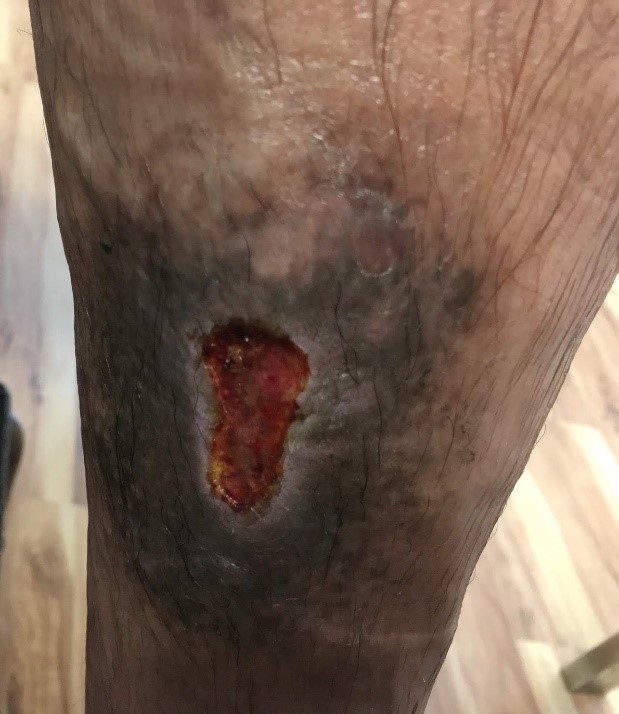Venous Ulcer Treated with Skin Graft
History:
29-year old woman presenting with a 6 X 3 cm ulcer over the left medial lower leg. It has been present for 2 years and has been treated with dressing changes but not with compression. It is painful and has slowly increased in size. She has a job requiring her to be on her feet all day. No significant medical history and no history of trauma.
Findings:
The foot pulses are palpable and bounding. The leg has moderate to severe edema especially over the foot and a significant number of varicose veins in the leg and ankle and foot. There is a 6 X 3 cm and .4 cm deep ulcer in the medial mid lower leg. The ulcer is painful and sensitive to touch. The skin around the ulcer shows dark bluish, purple discoloration and hyperpigmentation.
Diagnosis: Venous leg ulcer. Diagnosis is made by history and clinical examination and ulcer characteristics. Differential Diagnosis: Rule out arterial disease, mixed venous/arterial ulcer, pyoderma gangrenosum, vasculitis, cancer.

Fig. 1. 6 x 3 cm ulcer left medial lower leg
Diagnosis:
Differential Diagnoses:
Workup Required:
- Gross arterial disease was ruled out. Ankle/Brachial Index as well as peripheral pulses were recorded to be within normal limits.
- Color duplex ultrasound scanning with Valsalva or proximal compression showed multiple incompetent valves in both deep and superficial veins.
- The patient was referred to a Vascular Surgeon for evaluation of deep and superficial veins. The incompetent deep and superficial veins were noted but no operation on the veins was recommended.
- Deep swab culture showing mixed skin flora and no streptococci.
- With no suspicion of malignancy, no biopsy for pathology was done.
Plan:

Fig.2. Ulcer after 1 week of treatment
Expertise Needed:
Treatment:
- ULCER AND SKIN CLEANSING. The ulcer was cleaned with saline to remove loose debris and slough. The skin around the ulcer should be cleaned with soap and water to reduce skin flora.
- DEBRIDEMENT. Under local anesthesia with .5% Lidocaine with epinephrine adherent devitalized tissue and biofilm was removed using a scalpel. The edge of ulcer which was thickened and raised was excised.
- INFECTION CONTROL. The wound was rinsed with hypochlorous acid and after this a silver impregnated moist foam dressing was applied. As there was no significant cellulitis and a wound culture negative for beta hemolytic streptococci; no systemic antibiotics were prescribed. .
- DRESSING: The contamination was greatly reduced after one week and the silver dressing was discontinued. A synthetic contact dressing plus a moist foam dressing was then applied. There was relatively little drainage so the dressing was changed every 7 days.
- COMPRESSION. A short stretch compression bandage was applied to control edema and then changed with the dressing every 7 days.
- Split Thickness Skin Graft. After 4 weeks of treatment the ulcer was only reduced by 15% and the patient was scheduled for surgical debridement and a meshed split thickness skin graft.

Fig.3. Ulcer after 4 weeks of treatment
Follow Up:
Two months after grafting the ulcer is completely healed.

Fig.4. Healed ulcer 2 months after skin grafting

